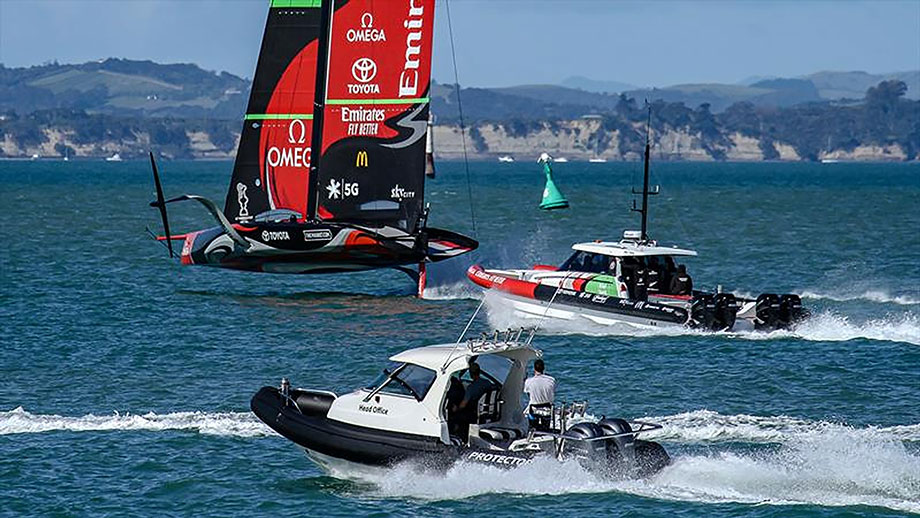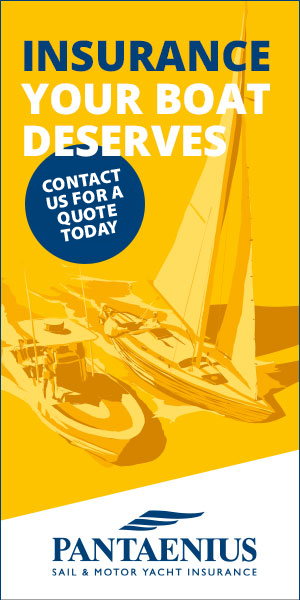In John Bertrand’s seminal tome Born to Win which documented Australia II’s dramatic win in Newport, Rhode Island in 1983 to end 132 years of Cup dominance by the USA, there is a line about spying: “…there was an uproar down at our dock just as the crew was awakening. Our guards caught an underwater cameraman in a wetsuit photographing the keel of Australia II. Phil Judge, our tender skipper, jumped into the water fully clothed, dragged him out and turned him over to Newport police. We dropped charges when the film was handed over and we had assurances that there was only one diver. But there were in fact two, and much later we found another film of our keel in the Canadian house.”
Spying in the America’s Cup has been far more than a recent phenomenon, documented even as far back to racing in the 19th century, but for modern teams it has been a significant budget drag with ever more sophisticated technology being deployed to measure, capture and record everything from outright speed through to manoeuvres, sail plans, wing design, onboard control systems and aero packages. Drones, trackers, submersibles even, have been rumoured as syndicates vie to get crucial data that could mean the difference between winning and losing.
As Matteo Plazzi, a member of the Recon Management Panel for Luna Rossa Prada Pirelli said: “Recon has always played an important role in AC campaigns. You have an event every three or four years and during this period you design and develop your new boat; understanding and knowing in which direction your opponents are going is crucial. The more info you have, the more simulations you can run in-house and get a feeling of where you are compared with your competitors.”
At the 36th America’s Cup in Auckland, the situation on the water was, at times, bordering on dangerous with multiple team spy vessels following and tracking individual AC75s as they went about their training schedule. Incidents of near-misses were recorded and all the teams agreed that the situation was unsustainable and needed addressing.
So, for the 37th America’s Cup, buried deep in the Protocol Document is a new and highly significant rule aimed at curbing the expenditure, reducing the frustration that teams have traditionally experienced of being spied upon and opening up the event for spectators to get a consistent view of developments and techniques that all the syndicates will be honing, in this cycle.
The ‘Reconnaissance’ rule is both broad and comprehensive putting spectators right in the heart of the action with stills, video and analysis that will be available to view publicly on www.americascup.com but equally forming a valuable, cost-saving service for all the teams.
Architect of the new initiative, Dan Bernasconi, from Emirates Team New Zealand, has been pining for change in this area for a while: “We started thinking about a shared recon programme a good few years before the last Cup and really it was all about making it safer on the water by reducing the armada of chase boats but also, it is about opening up the America’s Cup to its fanbase.
“We watched as a number of new technical websites and YouTubers sprung up to analyse Cup designs and it just felt that it was the right time to formalise an approach to open up the sport and give the media and fans direct access to recon data, analysis and commentary so they can track the developments as they happen. That is a big part of the whole fascination with the America’s Cup and this time fans will be in the box-seat as the AC40’s start sailing before the AC75’s splash in 2024.”
As we move towards training vessels being sailed alongside the much-anticipated launch of the AC40 fleet, the reconnaissance personnel, appointed by the teams but overseen by America’s Cup Events Limited, will be following each tack, gybe and daily runs both long and short of every on-the-water session. Data and imagery will be uploaded into the cloud for all teams to view and analyse as well as interviews with key helms, crews and designers on a daily basis to form a mass of engaging content. Crucially, this content will also be brought to fans and followers and will help to paint the picture of sailing’s pinnacle event – the 37th America’s Cup in Barcelona 2024.
Ben Cornish, the Reconnaissance Manager and appointed Recon Panel Member for the Challenger of Record, INEOS Britannia, is unequivocal on how the programme will benefit the event: “The biggest benefit of this program is the excitement it will create for the fanbase. Unlike previous campaigns, the public are going to be far more up to speed with what is going on with each team’s campaign. The content captured by teams would normally stay in-house, this time around the media and general public will be in the loop with team training and development.”
With all of the teams now well into their design programmes for their second generation AC75 – remember they are only allowed to build one AC75 for this America’s Cup – the reconnaissance may well focus on crewing technique as much as innovative design as INEOS Britannia’s Cornish explains: “From a team perspective, we had a strong recon presence during the last two campaigns. We observed all the teams when they were on the water. This was critical as the concept (AC75) had never been seen before and huge amounts could be learnt from observing other teams. Although people associate reconnaissance purely as a design requirement, it is actually a valuable tool for watching teams’ techniques in manoeuvres and how their crew operate in various playbooks versus our own.”
But the design race is very real, as it always is in the America’s Cup, and with the world’s best designers fusing together with influence from the aerospace industry and Formula 1 worlds in this cycle, all eyes will be on the reconnaissance gained as boats start sailing again. Marginal gains all add up and every team will be looking for maximum advantage to not only get through the Challenger Selector Series but to challenge Emirates Team New Zealand for the America’s Cup in October 2024.
“There are still areas of these boats where significant gains can be found,” added Dan Bernasconi, “the larger span of the foils creates a lot of avenues for the design teams to run through and things like the mainsail control system, the opening up of the hydraulics rule and the lighter weight of the boats makes for some interesting structural decisions to be made. There will be a lot to track in the recon programme. It will be exciting for the fans to see.”
Matteo Plazzi from Luna Rossa Prada Pirelli added: “In this period the RMP group is detailing formats of the information that the recon units will provide to all the teams and media groups; once this info is available, I am sure that each team will have its own internal group to analyse the info and start a daily communication process with the recon units to better investigate the specific details of the observed team.”
Ben Cornish is clear on the merits of effective reconnaissance: “Of course, you are always looking to see what direction other teams are heading with their design package and control systems. For AC37, as a refinement of the previous edition we can expect naturally the teams to become closer in boat performance and therefore the details and smaller margins may be what we end up looking for by the time racing happens.”
With AC40’s starting to roll off the production line at McConaghy’s in China, it willl not be long before teams start using them as effective design mules, testing out componentry and ideas that are currently sat on the design boards of the world’s greatest naval architects and engineers.
And the great news is that every development will be brought to you, the fans of the America’s Cup, in hi-definition with analysis and commentary. “There will be no more grainy images shot from miles away,” said Dan Bernasconi, “this will be the most accessible America’s Cup for fans around the world and the development picture that will be painted will be compelling, relevant and fascinating. The race for the Cup is well underway.”




















